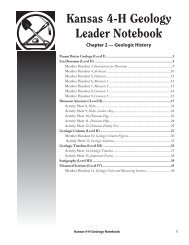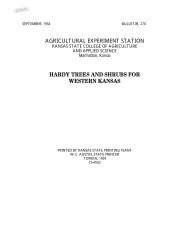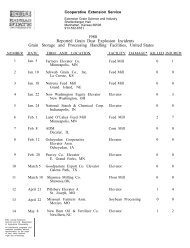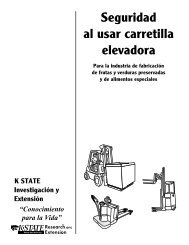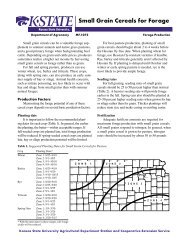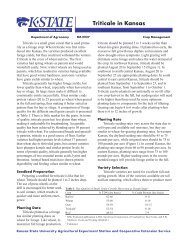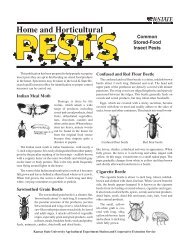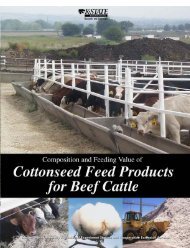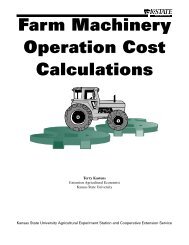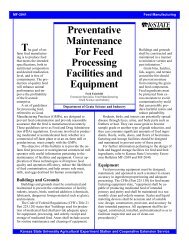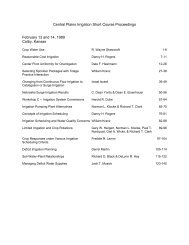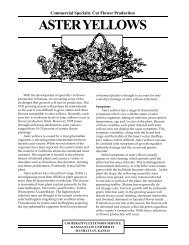MF2853 Control and Prevention of Hay Fires - K-State Research ...
MF2853 Control and Prevention of Hay Fires - K-State Research ...
MF2853 Control and Prevention of Hay Fires - K-State Research ...
Create successful ePaper yourself
Turn your PDF publications into a flip-book with our unique Google optimized e-Paper software.
<strong>Control</strong> <strong>and</strong> <strong>Prevention</strong><br />
<strong>of</strong> <strong>Hay</strong> <strong>Fires</strong><br />
Spontaneous combustion hay fires cost farmers thous<strong>and</strong>s <strong>of</strong> dollars in<br />
lost or damaged feed supplies, buildings, <strong>and</strong> income every year. Typically,<br />
these fires, which are preventable, occur within six weeks after baling.<br />
The fires can occur in hay stored inside as well as outside.<br />
What Causes <strong>Hay</strong> <strong>Fires</strong>?<br />
Regardless <strong>of</strong> when or where the fire occurs, the most common cause is excessive<br />
moisture. Heating caused by plant cell respiration (the burning <strong>of</strong> plant<br />
sugars to produce energy) in hay bales is normal <strong>and</strong> generally <strong>of</strong> little consequence.<br />
Heating occurs to some extent in all forage material unless it contains<br />
less than 15 percent moisture. However, if bale moisture levels are too high<br />
(greater than 20 percent), the heat <strong>and</strong> moisture create a suitable environment<br />
for the growth <strong>and</strong> multiplication <strong>of</strong> mesophilic (warm temperature) bacteria<br />
that are present on forage crops. Respirating mesophilic bacteria release heat<br />
in the bale, creating interior bale temperatures that can reach 130° to 140° F.<br />
Within this temperature range, most mesophilic bacteria die <strong>and</strong> interior bale<br />
temperatures start to decline.<br />
Microbial action occurs because freshly cut forage is not dead. Respiration<br />
continues in plant cells after cutting, releasing a small amount <strong>of</strong> heat in the<br />
bale. Many producers refer to this elevation in bale temperature as “sweating”<br />
or “going through a heat.” In hay that is baled at the proper moisture concentration,<br />
plant cell respiration has slowed dramatically <strong>and</strong> will eventually stop<br />
on its own.<br />
The potential for fire occurs when the interior bale temperature does not cool<br />
after the first heating cycle. Temperatures rise when the heat created by mesophilic<br />
bacteria makes an environment favorable for the growth <strong>and</strong> multiplication<br />
<strong>of</strong> thermophilic (heat loving) bacteria. The thermophilic organisms<br />
multiply <strong>and</strong> produce heat that can raise the interior bale temperature to 170°<br />
F before microbial activity ceases.<br />
This cycle <strong>of</strong> heating <strong>and</strong> cooling may occur several times during the weeks<br />
after baling as the microbial population increases <strong>and</strong> decreases. However,<br />
the maximum temperature decreases during each subsequent cycle <strong>and</strong> the<br />
interior bale temperature eventually stabilizes near the ambient temperature.<br />
<strong>Hay</strong> that experiences these heat cycles loses much <strong>of</strong> its quality as a feed<br />
source, but is unlikely to catch fire. In some cases, cows may actually prefer the<br />
taste <strong>of</strong> the brown, heat-damaged hay but the nutritional value has decreased<br />
considerably.<br />
Reducing the Risk <strong>of</strong> <strong>Hay</strong> <strong>Fires</strong><br />
<strong>Hay</strong> moisture concentration is a major factor in the microbial activity that<br />
leads to hay fires. Therefore, hay should be cured to the proper moisture concentration<br />
before baling. Moisture levels for safe storage <strong>of</strong> hay vary with size<br />
<strong>and</strong> density <strong>of</strong> bale <strong>and</strong> type <strong>of</strong> hay. In general, hay in small rectangular bales<br />
Kansas <strong>State</strong> University Agricultural Experiment Station <strong>and</strong> Cooperative Extension Service<br />
John Slocombe, Pr<strong>of</strong>essor,<br />
Ag Machinery<br />
Lyle Lomas, Pr<strong>of</strong>essor,<br />
Southeast Agricultural<br />
<strong>Research</strong> Center<br />
K-<strong>State</strong> <strong>Research</strong> <strong>and</strong><br />
Extension
Figure 1. Homemade hay<br />
temperature probe with<br />
thermometer.<br />
2<br />
should be baled at less than 22 percent moisture to keep molding <strong>and</strong> heating<br />
to a minimum. Large rectangular <strong>and</strong> large round bales retain internal heat<br />
much longer than conventional bales. Therefore, hay should be less than 18<br />
percent moisture before baling in large bales. If you are storing or sheltering<br />
some <strong>of</strong> your big bales, this long-term heat retention affects the proper time<br />
to move big bales into storage. <strong>Hay</strong> baled with more than 22 percent moisture<br />
should probably not be put into storage for at least 30 days. This is especially<br />
true if bales are to be stacked several layers deep. With the threat <strong>of</strong> barn fires<br />
removed by outside hay storage, many operators <strong>of</strong> large round balers try to<br />
bale hay with too much moisture. But excessive heating <strong>and</strong> molding can<br />
cause the loss <strong>of</strong> as much as one-third <strong>of</strong> the feeding value <strong>of</strong> hay baled at 28<br />
percent moisture.<br />
Carefully monitor the weather forecasts before scheduling hay baling operations.<br />
Weather conditions during hay curing have the greatest influence on<br />
achieving proper moisture concentration. Ideal hay-curing weather is slightly<br />
windy with a relative humidity <strong>of</strong> 50 percent or less. <strong>Hay</strong> should not be baled<br />
in the early morning because its moisture concentration increases overnight<br />
when the air tends to be more humid.<br />
Specialized hay equipment can help reduce moisture concentration by increasing<br />
crop drying rates, especially during good hay-curing weather. Conditioning<br />
equipment crimps or roughens crop stems to break up the waxy outer<br />
layer surrounding the stem. Crimping allows plant moisture to evaporate <strong>and</strong><br />
speeds the drying process. Tedders fluff, spread, or move windrows to improve<br />
air movement through the crop. Windrow turning equipment lifts, inverts,<br />
<strong>and</strong> fluffs windrows, allowing the bottom side <strong>of</strong> the windrow to be exposed<br />
to the sun, which speeds drying during good hay-curing weather.<br />
<strong>Hay</strong> preservatives can cut the risk <strong>of</strong> hay fires by reducing the growth <strong>of</strong><br />
bacteria in moist hay. Propionic acid is a liquid that is applied to hay during<br />
baling <strong>and</strong> is the most effective preservative available. However, a tank <strong>and</strong><br />
a spray application system must be added to the baler to hold <strong>and</strong> dispense<br />
the preservative. Furthermore, spray nozzles must be spaced to distribute the<br />
chemical over all the forage as it enters the baling chamber.<br />
The amount <strong>of</strong> propionic acid needed depends on the hay moisture concentration.<br />
Small bales with a moisture concentration between 20 <strong>and</strong> 25 percent<br />
should be treated with about 0.5 percent propionic acid on an<br />
as-baled basis. The application rate should be increased to 1 percent<br />
for hay with a moisture concentration between 25 <strong>and</strong> 30<br />
percent. Propionic acid <strong>and</strong> other hay preservatives may not work<br />
for hay with a moisture concentration greater than 30 percent.<br />
The main disadvantages <strong>of</strong> using propionic acid are its corrosiveness<br />
<strong>and</strong> the cost <strong>of</strong> application equipment. The estimated cost <strong>of</strong><br />
adding spraying equipment to a baler is $1,000 to $1,500.<br />
<strong>Hay</strong> that is baled at the proper moisture concentration can<br />
become a potential fire hazard if it becomes wet during storage.<br />
<strong>Hay</strong> barns should be weather tight with adequate drainage<br />
so water will not enter the barn <strong>and</strong> damage hay during storms.<br />
<strong>Hay</strong> that is stored uncovered outside should be formed into the<br />
tightest packages possible to resist penetration by rain. Do not place unprotected<br />
bales or stacks tightly against each other. Instead, arrange uncovered<br />
bales so air can freely circulate around them to promote drying. Protect bales<br />
from ground moisture <strong>and</strong> run<strong>of</strong>f by placing them on a bed <strong>of</strong> gravel, old tires,
poles, or pallets. Plastic or other waterpro<strong>of</strong> covers will protect bales by shedding<br />
precipitation.<br />
Monitoring Temperatures During Storage<br />
The temperature <strong>of</strong> hay that has been baled at a high moisture concentration<br />
should be checked twice a day for six weeks after baling. Use a probe <strong>and</strong><br />
thermometer to accurately determine the temperature inside a stack <strong>of</strong> hay. A<br />
simple temperature probe can be made in the farm shop from a<br />
10-foot piece <strong>of</strong> ¾-inch diameter iron pipe. Drill eight ³/16-inch<br />
diameter holes about three inches from one end then hammer<br />
that end <strong>of</strong> the pipe together to form a sharp edge (Figure 1).<br />
Commercial temperature probes are available, but are <strong>of</strong>ten too<br />
short to monitor the maximum interior temperature zone within<br />
a hay stack.<br />
Check hay temperature in the center <strong>of</strong> the stacked hay bales.<br />
The easiest way to do this is from the top <strong>of</strong> the stack. Do not<br />
walk directly on the stacked hay because pockets may have<br />
already burned out under the hay surface. Place boards, plywood,<br />
or a ladder on the hay to walk on (Figure 2). This will spread<br />
the weight <strong>of</strong> the person monitoring the temperature over a larger area <strong>and</strong><br />
prevent falling into burned out cavities. Work in teams <strong>of</strong> at least two people<br />
<strong>and</strong> attach a lifeline to the person checking hay temperature just in case<br />
the surface collapses. The second person, st<strong>and</strong>ing safely away from the hay,<br />
should hold the other end <strong>of</strong> the lifeline (usually a heavy rope) to<br />
pull out the person monitoring the temperature in the event <strong>of</strong> a<br />
collapse.<br />
Drive the probe from the top <strong>of</strong> the hay stack to the inner most<br />
bales (Figure 3). Lower a thermometer to the end <strong>of</strong> the probe<br />
with a piece <strong>of</strong> light wire. After 10 to 15 minutes, retrieve the<br />
thermometer <strong>and</strong> read the temperature. If the temperature has<br />
reached 150° F, it is likely to continue to increase <strong>and</strong> bales<br />
should be moved to create more air circulation <strong>and</strong> cooling<br />
(Table 1). Continue monitoring the temperature every two or<br />
three hours.<br />
Table 1. Temperature interpretations for hay stacks<br />
Temperature (°F) Interpretation<br />
<strong>Hay</strong> <strong>Fires</strong><br />
In the event <strong>of</strong> a hay fire, surveying the fire scene is the most important step<br />
to ensure everyone’s safety. Scan the area surrounding the hay fire. If flammable<br />
products (e.g. gasoline, fertilizers, <strong>and</strong> pesticides) are located nearby,<br />
evacuate the area immediately <strong>and</strong> wait for firefighters to arrive. Do not attempt<br />
to remove the flammable products.<br />
If there are no flammable products in the area <strong>and</strong> time permits, there are<br />
steps you can take before the fire department arrives.<br />
• For hay stored outside, create a firebreak around the stacked hay by<br />
disking a 15-foot wide perimeter around the stack. If water <strong>and</strong> a<br />
high-pressure hose are available, water the hay <strong>and</strong> the surrounding<br />
vegetation to keep the fire from spreading.<br />
• For hay stored inside a building, if the area is safe <strong>and</strong> time permits,<br />
evacuate all livestock from the building. Relocate animals to an area<br />
that is a safe distance from the structure. Turn <strong>of</strong>f the building’s electricity<br />
to prevent an electrical fire. Monitor wind direction carefully. If<br />
water <strong>and</strong> a high-pressure hose are available, water the ro<strong>of</strong> <strong>of</strong> adjacent<br />
structures that are downwind <strong>of</strong> the fire.<br />
Damaged <strong>Hay</strong><br />
<strong>Hay</strong> that has been damaged by heat, smoke, or water should be removed to a<br />
safe location. Use damaged hay as mulch for erosion control on slopes or in<br />
gullies. If you are uncertain whether heat-damaged hay is suitable for feeding,<br />
have a sample tested.<br />
Publication modified <strong>and</strong> illustrations used with permission from <strong>Hay</strong> Fire <strong>Prevention</strong><br />
<strong>and</strong> <strong>Control</strong>, Virginia Cooperative Extension Service, publication 442-105, 2003, Gay,<br />
Susan W., Grisso, Robert “Bobby”, Smith, Ray, <strong>and</strong> Swisher, Jerry M., Jr.<br />
Br<strong>and</strong> names appearing in this publication are for product identification purposes only. No endorsement is intended,<br />
nor is criticism implied <strong>of</strong> similar products not mentioned.<br />
Publications from Kansas <strong>State</strong> University are available on the World Wide Web at: www.oznet.ksu.edu<br />
Contents <strong>of</strong> this publication may be freely reproduced for educational purposes. All other rights reserved. In each case, credit<br />
John Slocombe <strong>and</strong> Lyle Lomas, <strong>Control</strong> <strong>and</strong> <strong>Prevention</strong> <strong>of</strong> <strong>Hay</strong> <strong>Fires</strong>, Kansas <strong>State</strong> University, December 2008.<br />
Kansas <strong>State</strong> University Agricultural Experiment Station <strong>and</strong> Cooperative Extension Service<br />
<strong>MF2853</strong> December 2008<br />
K-<strong>State</strong> <strong>Research</strong> <strong>and</strong> Extension is an equal opportunity provider <strong>and</strong> employer. Issued in furtherance <strong>of</strong> Cooperative Extension Work, Acts <strong>of</strong> May 8 <strong>and</strong> June<br />
30, 1914, as amended. Kansas <strong>State</strong> University, County Extension Councils, Extension Districts, <strong>and</strong> United <strong>State</strong>s Department <strong>of</strong> Agriculture Cooperating, Fred<br />
A. Cholick, Director.



